Air of Authority - A History of RAF Organisation
Plant Equipment - AP3036, Part 4 (1st Ed) & Part 5 (2nd Ed) - Concreting Equipment (became Part 6 (2nd Ed) - AL77)
(1st Ed) indicates that the Part/Section was in the original 1st Edition of AP3036. (2nd Ed) indicates that the Part/Section was in the original 2nd Edition of AP3036, whilst the addition of AL? indicates which Amendment List, introduced this Part/Section following the original release of AP3036 (2nd Edition)
|
Millars' Batching Hoppers |
|
|
|
|
| Description |
The batching hopper arrangement shown above allows material to he stored in compartments and specified amounts to be released into tipping wagons which run on a light railway track. The outfit consists of twin steel hoppers of 2 cu. yd. total capacity, mounted on a steel frame straddling the light railway track. The hoppers are fitted at the bottom with discharge doors operated by hand levers. |
| Operation | The above layout drawing shows a typical installation for feeding a 14/10 high discharge concrete mixer with aggregate. The aggregate may be loaded into the hoppers by means of a grab or a portable belt conveyor. |
| Data |
The weight of a complete batching hopper unit is: - Rails - 3½ cwt per set. Hopper - 13¾ cwt Wagons - 16 cwt, each. |
|
Blaw-Knox Junior concrete weigh batcher (mobile) |
|
|
|
|
| Description |
This item of equipment appears to have been added to the 2nd Edition by the issue of AL57. |
| Machine Specification |
Main hopper - 20 cu. yd. total capacity; detachable flare-plates; discharged by guillotine type doors.
Weigh hopper - 26 cu. ft. capacity; discharged by counterbalanced gate type door and chute Dial indicator - Parsons, Type 6090/91; 2,240 lb. x 5 lb. Running Gear Suspension - 7-leaf, semi-elliptic springs Axle - Solid, square section Wheel bearing - Taper roller Wheels - Two, size 3.75 in. x 13 in.; 6-stud fixing, 18 mm. on 205 mm. PCD, 160 mm. bore Tyres - Pneumatic, 25 in. x 6 in., 8-ply rating, standard tread Brakes - Overrun type; wedge type brake shoes operating in 10 in dia. x 1-3/8 in. wide drums Support leg - Adjustable 17 In. to 26 in. Towing attachment - Detachable draw-bar, with 3 in. dia. towing eye |
| Data |
Dimensions
Weight - 8,704 lb |
|
Road Machines 20 cu yd concrete weigh batcher (mobile) Mk 1 |
|
|
|
|
| Description |
MT required for transportation -
This item of equipment appears to have been added to the 2nd Edition by the issue of AL77. |
| Operating Data |
Capacities
Working dimensions Plant in working condition with trailer chassis removed and superstructure supported to give a 2 ft. 6 in. discharge height to the discharge door of the weighbucket. Overall length, main hopper flareulates - 12 ft 6 in Overall width, across flareplates - 11 ft 6 in Overall height, top of dividing plates - 15 ft 1 in Loading height - 14 ft 3 in Discharge height - 2 ft 6 in Swing clearance for weighbucket - Add 4 ft 0 in to both the overall length and the overall width.
|
| Data |
Dimensions - Partially dismantled, trailer chassis fitted, ready for towing
General information
Weight 2,500 lb |
|
Road Machines 20 cu yd concrete weight batcher (mobile) Mk 2 |
|
|
|
|
| Description |
MT required for transportation -
This item of equipment appears to have been added to the 2nd Edition by the issue of AL77. |
| Operating Data |
Capacities
Working dimensions Plant in working condition with trailer chassis removed and superstructure supported to give a 2 ft. 6 in. discharge height to the discharge door of the weighbucket. Overall length, main hopper flareplates - 12 ft 10 in Overall width, across flareplates - 11 ft 8 in Overall height, top of dividing plates - 15 ft 4 in Loading height - 14 ft 6 in Discharge height - 2 ft 6 in Swing clearance for weighbucket - Add 2 ft 0 in to both the overall length and the overall width. |
| Data |
Dimensions - Partially dismantled, trailer chassis fitted, ready for towing
General information
Weight 2,500 lb |
|
Millars' Concrete Mixer Type 14/10, Standard, Mk I & Mk II |
|
|
|
|
| Description |
MT required for transportation -
This item of equipment first appeared in AP3036 (1st Edition) but this entry has been updated to AL38, 2nd Edition |
| Engines |
Mk I - Ruston & Hornsby, Type PB, single cylinder, water-cooled, petrol/paraffin engine: Mk II - Ruston & Hornsby, Type 1VSO or 1VSH, single cylinder, water-cooled, Diesel engine: Both engines - Swept volume - 1.093 cc: BHP - 7½ at 1,000 rpm |
| Operating Data | 10 cu ft of concrete per operation |
| Data |
Working weight - 2 tons 13 cwt. Overall dimensions: -
Fuel consumption (Mk I) - 6 pints per hour. |
|
Millars' Concrete Mixer Type 14/10, High Discharge, Mk I & Mk II |
|
|
|
|
| Description |
The 14/10 high discharge mixer is identical with the standard mixer (see entry above) of the same capacity, except that the whole mixing unit is raised on a steel gantry mounted on four steel road wheels and fitted with a towing bar. The difference between the two Marks is the same as for the standard mixer. The height of discharge of mixed concrete is 6 ft. 6 in. above ground level in order that dumpers and lorries may receive mixes direct from the discharge chute. |
| Operation | As the Standard models shown above. |
| Data |
Working weight - 3 tons 4 cwt Overall dimensions: -
Fuel consumption (Mark I) - 6 pints per hour. |
|
Millars' Concrete Mixer Type 10/7 (Trailer Mounted) |
|
|
|
|
| Description |
This vehicle was shown in AP3036 (1st Edition) so was probably in use before 1944. When AP3036 (2nd Edition) was issued, it was still included. MT required for transportation -
|
| Operation |
The output of mixed concrete per operation is 7 cu. ft. The number of operations per hour varies according to the individual conditions, from 10 to 15, thus giving an output per 8 hour day of from 21 to 31 cu yd of concrete. Great care must be taken to level up the machine both ways before commencing work, and all weight must be taken off the pneumatic tyres by means of the jacks fitted. Failure to do this may result in a strained frame, undue wear of the mixing drum rollers, and damage to the pneumatic tyres. The mixer should be set up if possible so that the prevailing wind does not blow dust and cement into the engine. The length of time required for mixing depends on the materials and the amount of water in the mix. Particular care must be taken when shutting down for meal times and at the close of the day's work to ensure that the mixing drum is left free from concrete, by washing out with gravel (or stone) and water. The mixer may be towed for considerable distances, but at speeds not exceeding 20 mph and whenever moved should be inspected on arrival at the new site to ensure all bolts and nuts are tight and that no damage has resulted due to transportation. |
| Data |
Working weight - 4,592 lb Overall dimensions: -
Tyres - 27.00 x 6 in Fuel consumption - 3½ pints per hour. |
|
Millars' Concrete mixer, Type 7 NT |
|
|
|
|
| Description |
MT required for transportation -
This item of equipment appears to have been added to the 2nd Edition by the issue of AL31. |
| Engine |
Ruston Hornsby IVTH: Capacity - 809 cc: BHP - 5 at 1,000 rpm |
| Operation |
Cone clutch on engine shaft to countershaft; chain drives to drum bevel gear and loader shaft. Release of loader brake lowers loader to ground; loader filled to capacity gives correct charge. The loader is raised by moving the lever in the reverse direction to engage the clutch. The discharge chute is inserted in the drum by moving the lever at the left rear of the plant. |
| Technical Data |
Model Running gear - 4-wheeled trailer, steel wheels or pneumatic tyres; pivoting axle beam. Unsprung, with rocking beam axle and jacks. Mixing drum - Rotary non-tilting 7 cu. ft. capacity; fixed steel agitator blades. Scoop to discharge "mix" into barrows. Water tank meters supply into drum. Controls - Water tank control, loader clutch and brake (combined) and discharge scoop lever Working weight - 2 tons ¼ cwt Overall dimensions: -
|
|
Millars' Concrete mixer, Type 10NT |
|
|
|
|
| Description |
MT required for transportation -
This item of equipment appears to have been added to the 2nd Edition by the issue of AL31. |
| Engine |
Ruston Hornsby IVSH or IVSO: Capacity - 1,093 cc: BHP - 7½ at 1,000 rpm |
| Operation |
Centrifugal clutch operates at 450-550 rpm, enabling engine to be started in neutral. The loader control lever lowers the loader bucket to the ground; loader filled to capacity is correct charge of aggregate. The water valve controls are operated in turn, half the amount being admitted before the aggregate to wash the drum, and half after the drum is filled. The loader is raised by moving the lever inwards, towards the centre of the machine, so engaging the clutch and rotating the winding shaft. The discharge chute is inserted in the drum by operation of the lever on the left of the group. |
| Technical Data |
Running gear - 4-wheeled pneumatic-tyred trailer with centre-point steering. Unsprung, with rocking-beam front axle mounting and jacks. Stabilizers fitted to right side wheels only. Mixing drum - Rotary non-tilting; 10 cu. ft. capacity; fixed steel agitator blades scoop to discharge "mix" into barrows. Water tank meters supply into drum. Controls - Two water valves, loader clutch and brake (combined) and discharge scoop lever. Working weight - 2 tons 15 cwt Overall dimensions: -
|
|
Goodwin concrete mixer Type 10 NT |
|
|
|
|
| Description |
This item of equipment appears to have been added to the 2nd Edition by the issue of AL66. |
| Engine |
Lister, Type FR1, single-cylinder, water-cooled, Diesel engine: BHP - 7¼ at 1,400 rpm |
| Operating Data |
Minimum turning circle (radius) - 20 ft. 0 in. Maximum safe towing speed - 10 mph. NOTE - This machine is not fitted with brakes Maximum capacity of loading hopper - 5 cu ft (unmixed) Output of drum - 14 cu ft (mixed concrete per operation) Metered water supply
Water metering adjustment - Adjustable by increments of ¼ pint (1/8 turn of handle between min and max) Size of skip rope - 7/16 in dia x 25 ft 6 in Size of barrel rope - 7/16 in dia x 36 ft 0 in Working Dimensions Height of hopper lip when lowered for loading - 12½ in Height of hopper lip when fully raised - 9 ft 9 in Height of discharge spout - 2 ft. 11 in. Overall width with hopper on the ground and discharge spout 'out'- 11ft 11in |
| Technical Data |
Weights
Overall dimensions: -
|
|
Parker concrete mixer, Model 14/10 |
|
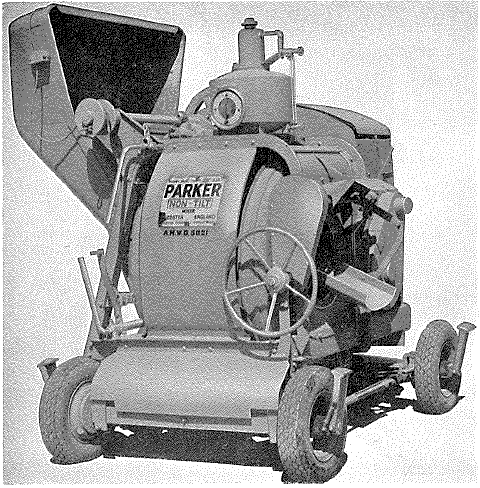 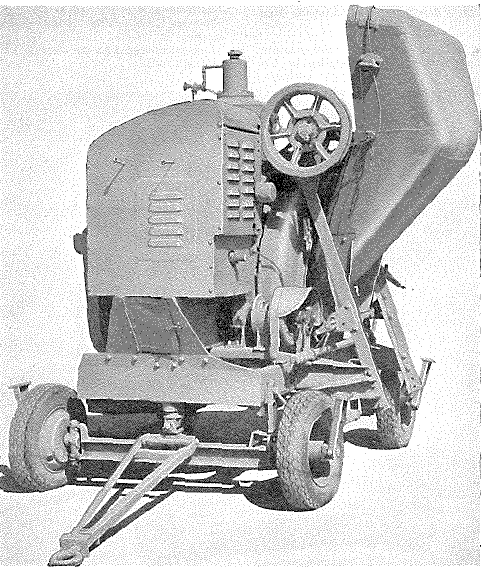 |
|
| Description |
Stores Ref - 89D/15 MT required for transporting: -
This item of equipment appears to have been added to the 2nd Edition by the issue of AL83. |
| Engine |
Petter, Type AV2, 2-cylinder, water-cooled, Diesel engine: BHP - 8 at 1,200 rpm /10 at 1,500 rpm |
| Operating Data |
Batch capacity
Capacity of water tank - 13 gall Dimensions Charging opening - 1 ft. 11 in. Diameter of drum - 4 ft. 3 in Length of drum - 3 ft. 0 in |
| Technical Data |
Dimensions (not shown above): -
Weights
|
|
Parker concrete mixer Model 10/7 |
|
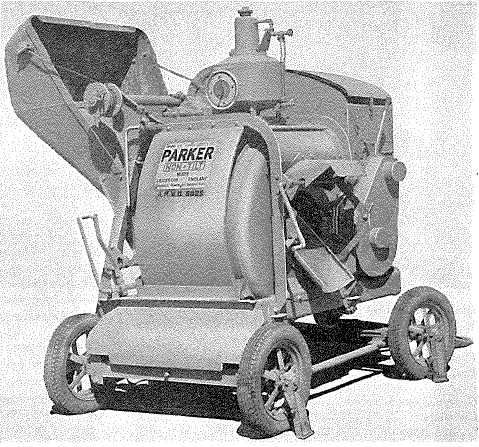 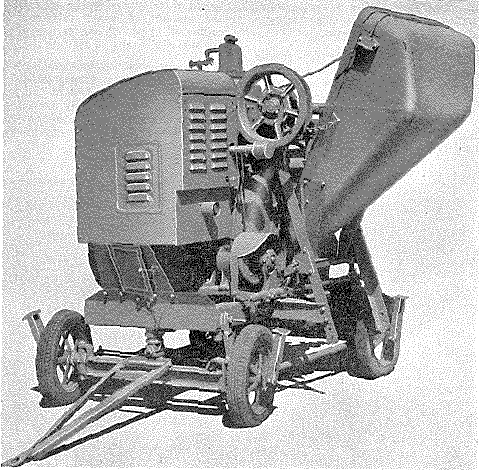 |
|
| Description |
Stores Ref - 89D/23 MT required for transporting: -
This item of equipment appears to have been added to the 2nd Edition by the issue of AL83. |
| Engine |
Petter, Type AV2, 2-cylinder, water-cooled, Diesel engine: BHP - 8 at 1,200 rpm /10 at 1,500 rpm |
| Operating Data |
Batch capacity
Capacity of water tank - 9½ gall Dimensions Charging opening - 1 ft. 11 in. Diameter of drum - 3 ft. 9¼ in Length of drum - 2 ft. 9½ in |
| Technical Data |
Dimensions (not shown above): -
Weights
|
| Benford, 3 cu ft Concrete Mixer, Model KR-12 (Trailer mounted) | |
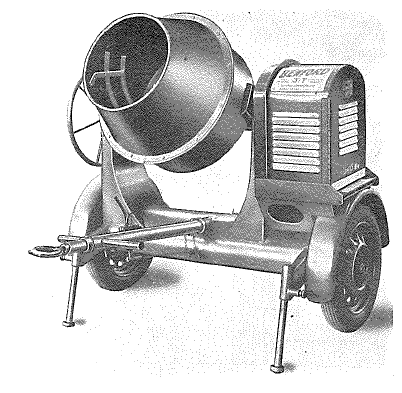 |
|
| Description |
Stores Ref - 89D/25 MT required for transporting: -
This item of equipment appears to have been added to the 2nd Edition by the issue of AL85. |
| Engine |
Villiers, Model 12 RG, single-cylinder, side valve, air-cooled, petrol engine: BHP - 1.2 at 2,000 rpm (governed) |
| Operating Data |
Maximum capacity of drum - 5 cu. ft Output of drum - 3 cu. ft. mixed per batch Height of drum mouth in filling position - 3 ft. 5 in Height of drum mouth in discharge position - 2 ft. 1 in. Size of drum mouth - 1 ft. 7 in. (dia.) Speed of mixing drum - 20 rpm. Clearance height for operating - 5 ft. 8 in Dimensions - see below
|
| Technical Data |
Overall Dimensions
Nett Weight - 952 lb |
|
Koehring mixer and paver, 100 tph, |
|||||||||||||
|
|
|||||||||||||
| Description |
MT required for transportation -
This item of equipment appears to have been added to the 2nd Edition by the issue of AL27. |
||||||||||||
| Engine | General Motors, Type 4-71, 4 cylinder, water cooled, Diesel engine: Capacity - 283.7 cu in: BHP - 103 at 1,800 rpm | ||||||||||||
| Operation |
By the operation of the 2-speed lever, two forward speeds and one
reverse are obtainable, and the speed over the ground in miles per hour
are given in the following table:
Mixing and discharge of the concrete is done automatically by the batchmeter, or operation of manual controls performs each phase of the cycle as necessary Capacity of paver - 34 cu. ft. Mixing time - Normally I mm. Output - 50 batches per hour at 2 min mixing time, or a maximum output of 86.7 batches per hour at 1min. mixing time (56.5 cu. yd.) |
||||||||||||
| Technical Data |
Running Gear (tracks)
Working weight - 48,580 lb Overall dimensions: -
|
||||||||||||
|
Foote mixer and paver, Multifoote Model 34E |
|
|
|
|
| Description |
MT required for transportation -
This item of equipment appears to have been added to the 2nd Edition by the issue of AL39. |
| Engine | Hercules, Type RXLD, 6 cylinder, water cooled, Diesel engine: Capacity - not stated: BHP - 1not stated |
| Machine Specification |
Running gear - Two tracks Main engine clutch - Twin disc type Steering system - Steering brakes located under the skip end of the machine Loading skip - Located and hinged at rear of machine Mixing drum - Double-cone type Discharge chute - Discharges concrete into the bucket Boom and bucket - Bucket is suspended from the boom and has a 6-in. spreading radius. The boom can swing left or right in a 160 degree arc and can also be raised and lowered. The bucket discharge doors are operated by cable control Water system - Consists of tanks and mechanism for storing and feeding a predetermined amount of water at the right time for each batch. Batchmeter - Times the mix, locks the discharge chute in the closed position until the mixing time is completed, and then unlocks it, rings a gong to signal to the operator when the mix is completed, and records on a counter the total number of batches mixed. Controls: Drive and adjustment - Drum drive sliding gear lever; power take-off lever; water measurement clutch control lever; and the water measurement control lever Charge, mix and discharge - Boom swing and lift shifter clutch lever; boom swing or lift lever; skip hoist lever; skip hoist ratchet lever; skip hoist auxiliary lever; boom bucket lever; power discharge lever; water control lock lever; and water control lever Traction - High and low speed pedal; forward and reverse lever; traction friction clutch lever; steering clutch lever; left steering brake pedal; left steering brake control lock ratchet; right steering brake pedal; and right steering brake control lock ratchet Methods of operating - Automatic or manual |
| Technical Data |
Weight-
Dimensions: -
|
|
Blaw-Knox concrete spreader, Model SA |
|
|
|
|
| Description |
MT required for transportation -
This item of equipment appears to have been added to the 2nd Edition by the issue of AL39. |
| Engine | Continental, Type PF226, 6 cylinder, water cooled, petrolengine: Capacity - 226 cu in: BHP - not stated |
| Machine Specification |
Power take-off - Straight through drive to main transmission. Clutch - 10 in Single plate (twin disc), toggle operated type with ball bearing thrust collars Transmission (four speed)
Wheels - 4 x Double-flanged split type, flat split type or Closure split type. Controls Mechanical - Ignition switch, choke rod, governor control lever, main clutch and brake control lever, forward and reverse lever, first and third speed lever, first or third and second speed lever, fourth speed lever, trolley lever, steering clutch and brake levers, trolley handwheel and power unit oil pressure indicator Hydraulic - Strike-off lift valve, regulating valve and hydraulic pressure gauge |
| Technical Data |
Weight-
Dimensions: -
|
|
Blaw-Knox concrete finisher, Model XC |
|
|
|
|
| Description |
MT required for transportation -
This item of equipment appears to have been added to the 2nd Edition by the issue of AL42. |
| Engine | Hercules, Type IXB-5, 4 cylinder, water cooled, petrol engine: Capacity -133 cu in: Compression ratio - 5.92 to 1: BHP - not stated |
| Machine Specification |
Clutch -
Single plate, roller operated type Transmission - Six traction speeds and four screed speeds Traction Speeds
Screed Speeds (strokes per min)
Speed of rotation of vibrator units (frequency) - 4,100 rpm |
| Technical Data |
Weight-
Dimensions: -
|
|
Foote mixer and paver, Multifoote Model 27E |
|
|
|
|
| Description |
This item of equipment appears to have been added to the 2nd Edition by the issue of AL52. |
| Engine | Hercules, Type RXC, 6 cylinder, water cooled, petrol engine: Capacity -529 cu in: BHP - 131.5 at 2,300 rpm |
| Machine Specification |
Running gear - Two tracks Main engine clutch - Twin disc type Steering system - Steering brakes located under the skip end of the machine Loading skip - Located and hinged at rear of the machine Mixing drum - Double cone type Discharge chute - Discharges concrete into the bucket Boom and bucket - The boom can be swung right or left in a 160 deg. arc, and can also be raised and lowered. The bucket has a 6 in. spreading radius; the bucket discharge doors are operated by cable Water system - Consists of tanks and mechanism for storing and feeding a predetermined amount of water at the right time for each batch Batchmeter - Times the mix, locks the discharge chute in the closed position until the mixing time is completed, and then unlocks it, rings a gong to signal to the operator that the mix is completed and records on a counter the total number of batches mixed Controls
|
| Technical Data |
Weight- not stated Dimensions: - not stated |
|
Johnson tamping and screed board vibrator, Model 3 |
|
|
|
|
| Description |
MT required for transportation
This item of equipment appears to have been added to the 2nd Edition by the issue of AL79. |
| Engine | Villiers, Mark 10, single-cylinder, side valve, air-cooled, petrol engine: BHP - 1.3 at 3,000 rpm (governed) |
| Operating Data |
Operative width for a screed with one vibrator unit - 16 ft. Max. (between road forms) Operative width for a screed with two vibrator units - 21 ft. Max. (between road forms) Vibrating frequency - 4,000 vibrations per min. Vibrating amplitude - 0.13 inches Vibrating acceleration 5.9G Self travelling speed 20/30 ft. per min. Dimensions
|
| Technical Data |
Engine and vibrator unit (uncrated)
Handles, rollers and fittings (crated)
Weights
|
| Holman Concrete Compactor Model CC2/Holman Screed Board Vibrators, Models CC2 & CC3 | |
|
|
|
| Description |
The CC2 appears to have been added to the 2nd Edition by the issue of AL88 but this was joined by the CC3 in AL94, to which this entry has been amended. |
| Technical Data |
Maker's designation - Concrete compactors, Symbol CC.2 and CC.3 Air adapter - ¾ in. BSP male Channel length
Channel width - 4 in. Overall length
Overall width - 1 ft. 8 in. Weight
Free air consumption at 80 lb. per sq. in.
Maximum bay, width for effective compaction
|
| Climax poker vibrator, Model A70 | |
|
|
|
| Description |
Stores Ref - 89D/53 This item of equipment appears to have been added to the 2nd Edition by the issue of AL94. |
| Technical Data |
Maker's designation - Pneumatic vibrator, Type A.70 Air adapter - ½ in. BSP male Control - Push-button-type throttle valve Recommended air pressure - 75 to 100 lb. per sq. in. Air consumption - 35 cu. ft. of free air per mm. at 90 lb. per sq. in. pressure Lubrication - One oz. capacity lubricator mounted as a unit with the throttle handle Frequency - 11,500 rpm approx Capacity - Up to 16 cu. yd. of Concrete per hour Dimensions
Weight Complete with hose, throttle handle, and lubricator - 34 lb. |
| Holman Core cutter, Model BB | |
|
|
|
| Description |
Stores Ref - 89D/64 This item of equipment appears to have been added to the 2nd Edition by the issue of AL99. |
| Machine Specification |
Make and Model - Holman Model BB Type - Shot drilling, core cutter |
| Operating Data |
Diameter of shot bit - 6 in. Max. depth of core - 13 in. Shot size - No 8 chilled shot Operating speed
Dimensions (Working condition) Fordson tractor fitted with cutter
|
| Technical Data |
Dimensions (crated for shipment) Core cutter - 84 in. x 20 in. x 24 in. Jacks and frame members - 80 in. x 18 in. x 14 in. Weight (total crated) - 1,130 lb. |
The dates of the various Amendment Lists are shown below: -
|
Amendment List |
Date of issue |
Amendment List |
Date of issue |
Amendment List |
Date of issue |
Amendment List |
Date of issue |
|
1 |
Mar 1951 |
26 |
Nov 1951 |
51 |
Aug 1952 |
76 |
Mar 1956 |
|
2 |
May 1951 |
27 |
Nov 1951 |
52 |
Nov 1952 |
77 |
May 1956 |
|
3 |
Jul 1951 |
28 |
Nov 1951 |
53 |
Mar 1953 |
78 |
May 1956 |
|
4 |
Jul 1951 |
29 |
Nov 1951 |
54 |
Mar 1953 |
79 |
Jun 1956 |
|
5 |
Aug 1951 |
30 |
Nov 1951 |
55 |
Mar 1953 |
80 |
Jul 1956 |
|
6 |
Sep 1951 |
31 |
Dec 1951 |
56 |
Apr 1953 |
81 |
Aug 1956 |
|
7 |
Sep 1951 |
32 |
Dec 1951 |
57 |
Apr 1953 |
82 |
Aug 1956 |
|
8 |
Sep 1951 |
33 |
Dec 1951 |
58 |
Jun 1953 |
83 |
Sep 1956 |
|
9 |
Sep 1951 |
34 |
Dec 1951 |
59 |
Jun 1953 |
84 |
Dec 1956 |
|
10 |
Sep 1951 |
35 |
Dec 1951 |
60 |
Jul 1953 |
85 |
Apr 1957 |
|
11 |
Sep 1951 |
36 |
Dec 1951 |
61 |
Sep 1953 |
86 |
Jul 1957 |
|
12 |
Sep 1951 |
37 |
Dec 1951 |
62 |
Sep 1953 |
87 |
Jul 1957 |
|
13 |
Sep 1951 |
38 |
Dec 1951 |
63 |
Feb 1954 |
88 |
Oct 1957 |
|
14 |
Sep 1951 |
39 |
Dec 1951 |
64 |
Mar 1954 |
89 |
May 1958 |
|
15 |
Sep 1951 |
40 |
Dec 1951 |
65 |
Aug 1954 |
90 |
May 1958 |
|
16 |
Sep 1951 |
41 |
Dec 1951 |
66 |
Sep 1954 |
91 |
Aug 1958 |
|
17 |
Sep 1951 |
42 |
Jan 1952 |
67 |
Oct 1954 |
92 |
Sep 1958 |
|
18 |
Oct 1951 |
43 |
Jan 1952 |
68 |
Oct 1954 |
93 |
Dec 1958 |
|
19 |
Oct 1951 |
44 |
Feb 1952 |
69 |
Dec 1954 |
94 |
Feb 1959 |
|
20 |
Oct 1951 |
45 |
Mar 1952 |
70 |
? |
95 |
Mar 1959 |
|
21 |
Nov 1951 |
46 |
Apr 1952 |
71 |
? |
96 |
Feb 1959 |
|
22 |
Nov 1951 |
47 |
May 1952 |
72 |
Sep 1955 |
97 |
Apr 1959 |
|
23 |
Nov 1951 |
48 |
Jun 1952 |
73 |
Nov 1955 |
98 |
Jul 1959 |
|
24 |
Nov 1951 |
49 |
Jun 1952 |
74 |
Nov 1955 |
99 |
Nov 1960 |
|
25 |
Nov 1951 |
50 |
Jul 1952 |
75 |
Feb 1956 |
|
|
This page was last updated on 08/07/19